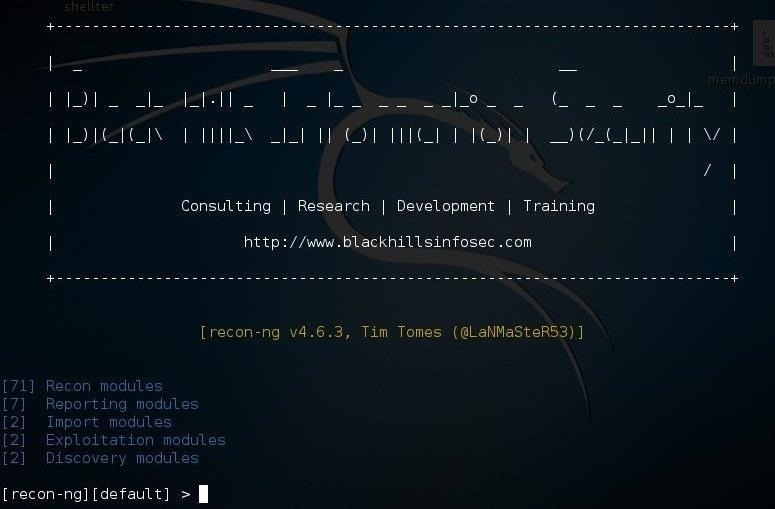Welcome back, my novice hackers!
As many of you know, recon is crucial to a successful hack/pentest. In most cases, hackers spend more time doing good reconnaissance than actually hacking. Without proper recon, you are simply guessing at what type of approach or exploit is going to work and, as a result, your time is wasted without any useful outcomes.
I have an entire series here on Null Byte on the various ways to approach reconnaissance, including such key tools as:
I encourage you to start with these reconnaissance tools and others before even considering hacking/exploitation.
In recent years, a brand new reconnaissance framework has become available to us that leverages many of the tools we are already using, but makes them far more powerful. This tool, Recon-ng, was developed by Tim Tomes while at Black Hills Information Security. He developed it as a Python script and tried to model its usage after Metasploit, making it easy for a pentester with Metasploit skills to use Recon-ng. It is built into Kali, so there's no need to download or install anything.
Let's explore its many and powerful capabilities a bit here.
Step 1: Starting Recon-Ng
Fire up Kali, open a terminal, and type:
kali > recon-ng

This will open a splash screen like below.

Note that the splash screen lists the number of modules by type. Unlike SET, but rather like Metasploit, we use commands and not numbers to use Recon-ng.
Step 2: Viewing Commands
At the prompt, let's type help in order to look at the commands we can use in Recon-ng.
recon-ng > help

Note that many of these commands are nearly identical to Metasploit including back, set, use, search, show, and unset.
Step 3: Showing Modules
To see all the modules in Recon-ng, we can type:
recon-ng > show modules

Since there are 84 modules in Recon-ng, I can't fit them all on one screen, or for that matter, even two.

Step 4: Viewing Keys
One of the strengths and beauties of Recon-ng is the use of various application programming interfaces (APIs) to extract useful recon information. For instance, Recon-ng can use Bing, Google, Facebook, Instagram, LinkedIn, and other online applications once you get the API key. With that key, you have almost unlimited access to that application.
To see what API keys Recon-ng can use, type:
recon-ng > keys list

As we can see, these are all the API keys that Recon-ng can use. Some are free and some you must pay for.
When you obtain an API key and you want to add it to Recon-ng for use, you simply add it to the keys. For instance, if I received an API key from Facebook and that key was "123456", I could add it to Recon-ng by typing:
recon-ng > keys add facebook_api 123456
Now when you list the keys, you can see that your facebook_api key is listed. This means that when you use the Facebook recon module, it will automatically use this key to access Facebook like a Facebook application would.

Step 5: Using Recon-Ng
Now that we have explored a bit of Recon-ng, let's try using one the modules that does not require an API key. There are many, but let's use one for scanning for XSS (cross-site scripting) vulnerabilities called XSSposed. We can load this module by typing:
recon-ng > use recon/domains-vulnerabilities/xssposed
This loads the module into memory and makes it ready for use. Let's get some info on this module by typing:
recon-ng > show info
Note the similarity to Metasploit syntax.

As you can see above, the only option we need is the website we want to scan. Let's scan our favorite website, WonderHowTo.com, to see whether it has any known XSS vulnerabilities.
First, set the source:
recon-ng > set source wonderhowto.com
Then tell Recon-ng to run:
recon-ng > run

Recon-ng uses XSSposed to then scan the site for known XSS vulnerabilities. Note that XSSposed found no XSS vulnerabilities in WonderHowTo.com. (Great job, Bryan!)
Now, let's try scanning the website of the leading IT security training company in the U.S., SANS.org, which teaches many courses on website and web app security.
recon-ng > set source sans.org
recon-ng > run

Notice that our good friends at SANS.org have not secured their own website. We found two vulnerabilities from 2015.
Recon-ng is one more tool in our hacker/pentester toolbox that provides us powerful capabilities for gathering necessary info on the target. In future tutorials in this series, we will explore its many varied capabilities, most particularly using APIs to garner key info on our target. So keep coming back, my novice hackers!
Just updated your iPhone? You'll find new emoji, enhanced security, podcast transcripts, Apple Cash virtual numbers, and other useful features. There are even new additions hidden within Safari. Find out what's new and changed on your iPhone with the iOS 17.4 update.






















9 Comments
Thanks for this great article OTW!!
my favorite recon tool.
@ OTW : how do you rate this tool among Nmap, Hping3, Shodan, Netcraft ,Maltego???
You can't really compare them as they all do different things.
I'm having a bit of trouble finding an article on what exactly I should be looking for when I perform recon, what all the info I get back actually means, or how that information can be useful. (Pretty new to hacking in general)
To hack effectively, you want to know as much possible about the target. This would include;
Either you don know how Recon-NG works and/or you simply don't read. The XSS module is matching any URL that contains the string SANS.ORG. The two vulnerable domains are solidaritypaySANS.ORG and gameartiSANS.ORG. They simply have that string as PART of the URL. If you came to me as a professional penetration tester and told me I was vulnerable and pointed to other peoples websites that would be the last job you did for me.
Are there other articles on recon-ng? Can't seem to find any using the search function.
great
Share Your Thoughts